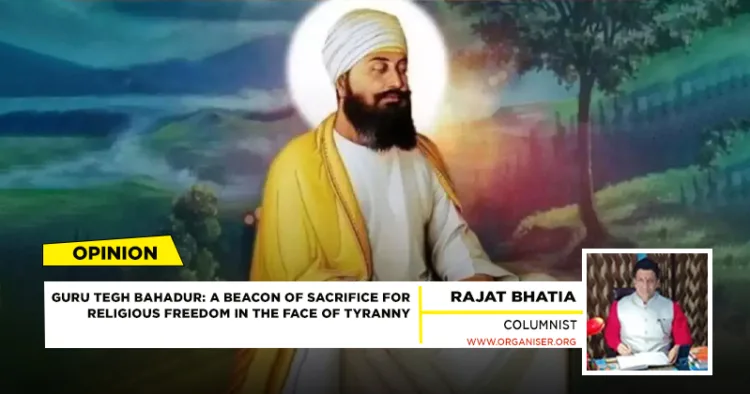Aurangzeb, who had a fanatic and religious mindset, issued many orders in India to please the Caliphs and Qazis, the main of which was: the order to demolish the famous temples of India issued in April 1669. In August 1669, the Vishwanath temple in Varanasi was demolished and a mosque named Gyanvapi was built at that place. The Somnath temple of Gujarat was also demolished by Aurangzeb. In the month of Ramzan in 1670, the famous Keshavrai temple of Mathura was also demolished. According to the orders of the cruel Mughals, famous temples were also demolished in places like Malwa, Odisha, Jodhpur, Ujjain, Udaipur, Maharashtra, Hyderabad etc., the number of which is about 40,000. To make the society capable and to re-establish harmony, the call of the time was that some great man, fearless and powerful, should lead the society selflessly. In such a period, destiny chose Guru Teg Bahadur Ji. All the qualities that the Indian nation needed were not present in anyone except Sant Shiromani Guru Teg Bahadur Ji. Guru Nanak Dev Ji was the first to oppose the atrocities of the Mughals. He addressed Babar as Jabar and asked the society to unite. Guru Arjun Dev Ji, the first martyr of the ten Guru tradition, took inspiration from Guru Nanak Dev Ji and took all the atrocities upon himself so that the society could protect the nation by awakening the spirit of manliness and unite and this happened with his sacrifice. Once again, in the need to unite the nation, Guru Teg Bahadur Ji moved forward on the path of sacrifice for the nation.
Due to the presence of Nanak Naam Leva Sangat in the entire Indian nation, Guru Ji kept getting news of Aurangzeb’s misdeeds in the society. In 1671, Aurangzeb made Iftikhar Khan the governor of Kashmir. To Islamize, Aurangzeb made Kashmiri Brahmins his target so that by weakening the Brahmins and breaking the backbone of the Indian society, religious inferiority could be created in the entire nation and the entire nation could be converted. According to British historian Macauliffe, “The mass experiment of Islamization first started in Kashmir by conversion.” According to Kojar Singh Kalaal, author of ‘Guru Vilas Padshahi’, the sacred threads of the Hindus who embraced Islam on the orders of Iftikhar Khan weighed 1.25 mons. According to a popular saying of the time, Aurangzeb would not eat until he got the news of the removal of 1.25 mons of sacred threads of Hindus.
The Kashmiri Pandits collectively organized a group discussion in Mattan and after getting everyone’s consent, a group of Kashmiri Brahmins under the leadership of Pandit Kriparam reached Anandpur Sahib. During the discussion between the Brahmins and Guruji, Guruji said that the only solution to these problems is that a truthful person with high ideals and conduct sacrifices himself for the protection of the nation. A nine-year-old boy Govind Rai, sitting nearby, said that who can be more worthy than you in the society at this time? The concept of sacrifice that was in the heart of Guru Teg Bahadur Ji was confirmed by his son Govind Rai. On hearing this, after getting permission from Guru Tegh Bahadur, Kashmiri Brahmins sent an order to Delhi that, “If the king can convert Guru Tegh Bahadur, then the entire Indian society will accept Islam with him by their own will.”
National poet Maithilisharan Gupt poeticized this moment-
Jao Vipvaro nirbhaye ho, likh do badshah ko pattar, Teg Bahadur Musalmaan ho to yah mat phaille sarvatar,
Vahi agrani aaj hamara hum sab bharti uske sang, dekhe kaya uttar deta hai iska anyayi aurang
Aurangzeb got furious on seeing the letters sent by Kashmiri Brahmins. He tried his best to break Guru Ji, but Guru Ji was engrossed in the will of God and was firm. In front of Guru Tegh Bahadur Ji, his three devotees- Bhai Sati Das, Bhai Mati Das and Bhai Dayala Das were given unbearable tortures so that on seeing them, Guru Ji would agree to convert his religion. Aurangzeb’s cruelty was at its peak, but the aura on Tegh Bahadur Ji’s face was worth seeing. A cruel ruler like Aurangzeb lost to the spiritual power of Guru Ji and in frustration he ordered to behead Guru Ji. According to the then times, on 24 November 1675, after taking bath, Guru Ji recited Japuji Sahib in a peaceful manner under the Banyan tree, seeing which even the executioner Jalaluddin got worried because there was no fear of death on his face at all. After reciting Japuji Sahib, Guru Ji was beheaded as per the order of the emperor.
To humiliate the hero of India, Guru Tegh Bahadur Ji and the entire nation, Aurangzeb ordered that no one would cremate his dead body. Opposing this, Bhai Jaita Ji wrapped his dead body in cotton and kept it in his house and set the whole house on fire and then set out for Anandpur Sahib with the head. When Bhai Jaita Ji handed over Guru Ji’s head to his son Govind Rai, Guru Govind Rai addressed Bhai Jaita Ji as ‘Rangreta Guru ka beta’.
Govind Rai cremated Guruji’s head with respect after reciting the holy Gurbani. Guru Tegh Bahadur Ji’s sacrifice for the nation was described by Gobind Singh Ji in Vichitra Natak-
Tilak janju rakha prabh taka, kano bado kalu mahi saka,
Sadhna hetu itti jinni kari, sees diya par si na uchari,
Dharam hetu saka jin kiya, seesu diya paru sirur na uchari..




















Comments